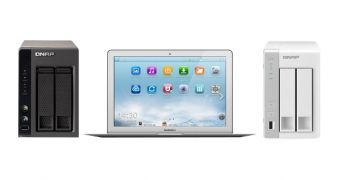QNAP Systems has officially introduced two new collections of network-attached storage devices, called Turbo NAS TS-x21 and TS-x20 and differentiated by something other than the obvious.
And by obvious we mean the number of bays in which a SATA hard disk drive unit (or SSDs, why not), can be inserted.
Indeed, normally, we would expect bay number to be the main difference between the Turbo NAS TS-x21 and TS-x20.
The two are identical in that regard though. In fact, both lines include versions with 1, 2 and 4 bays.
The actual differing feature is the processor and amount of memory backing it up.
For those unaware, NAS devices work on a principle similar to PCs: they have a CPU, though an admittedly weak one, and memory backing it up.
The TS-x21 series combines a 2 GHz chip with 1 GB of RAM, while the TS-x20 makes do with a 1.6 GHz chip and 512 MB DDR3.
"The QTS 4.0 is a major evolution of QNAP's software design," commented Meiji Chang, general manager of QNAP.
"It aims to reverse home users' typical impressions towards the networked appliances as being complex and hard to use. The QTS 4.0 integrates Turbo NAS hardware design and features multi-window intelligence and smart mobile apps, making home digital data storing and management easier and multimedia entertainment more fun."
The TS-x21 series has up to 4 hot-swappable bays, two USB 3.0 ports, one or two Gigabit Ethernet ports and, in one case, a LCM panel. The TS-x20 is the same, but there is no model with an LCM panel.
All newcomers have an intelligent desktop software suite with multi-window, smart Dashboard, event notifications, drag-and-drop icons, multiple desktops, personal wallpapers, and smart Toolbar with desktop preferences, online resources, quick search, quick Start menu, external device and background tasks.

 14 DAY TRIAL //
14 DAY TRIAL //